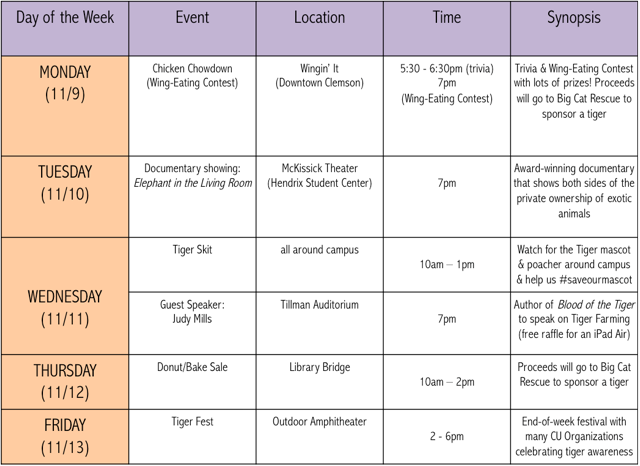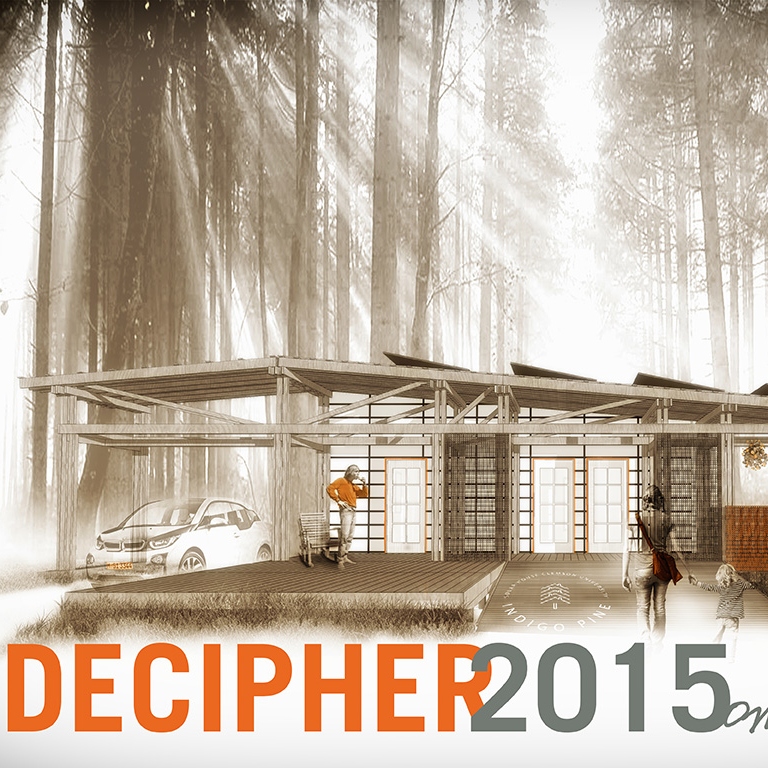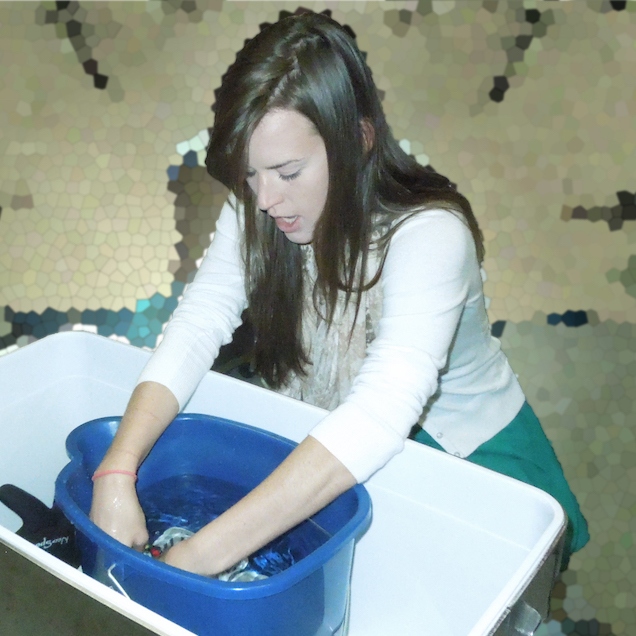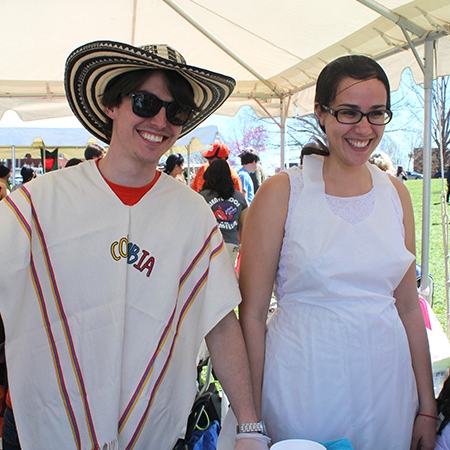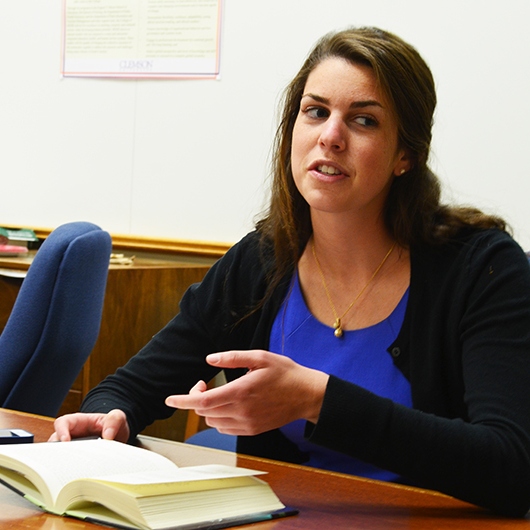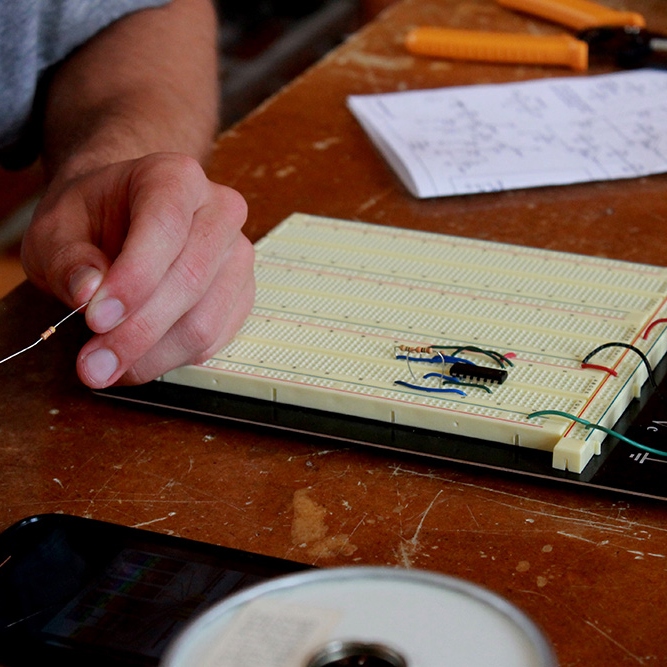Creative Inquiry
Decipher Debut
in Creative Inquiry Program/byPlease join us for the official debut of the 2015 issue of the Creative Inquiry magazine, Decipher, on Thursday, October 15, 2015 from 4-6:30 pm at the Cooper Library Lobby. We’ll provide refreshments and the opportunity to visit with students from CI projects and from the 2015 and 2016 Decipher teams.
Decipher is written and designed by undergraduate students to highlight the extraordinary work accomplished in Clemson’s Creative Inquiry program.
Learn more and download the iPad app at ci.clemson.edu/decipher.
Can You See The Rain?
in Creative Inquiry Program, Engineering, Computing and Applied Sciences/byBy Colby Lanham
Rainfall, itself, seems like a simple concept, but have you ever stopped to think about how hard it rains, the amount that falls or even how a raindrop is shaped?
In the Creative Inquiry project High-Speed Imaging of Rainfall, undergraduate students collect images to investigate raindrop shape, size and fall velocity. They then analyze these images in the context of the environmental factors and processes that govern these raindrop characteristics. By doing so, this project may identify measurement errors in polarimetric weather radar, a type of radar used to locate precipitation, calculate its motion and collect rainfall amounts.
This research is funded by the National Science Foundation and designated as Award No. AGS 1144846. It is offered as a Creative Inquiry project to support the project’s goals to integrate teaching and research and help develop the pipeline of well-educated, research oriented students who will pursue graduate studies in this field of study.
Undergraduate students are involved in every facet of the research. Students help to establish field sites, learn how to properly install the rainfall instruments, analyze data and participate in writing reports. Rain data will be collected over a two-year period with the goal to analyze as much rain as possible.
During their project meetings, students discuss their research progress and findings with the team leader Dr. Firat Testik, an associate professor in the Department of Civil Engineering. Once the data is collected, studied and processed, Testik and his students intend to publish their findings and present them at professional conferences.
Testik regards the development of thinking skills as a fundamental part of this Creative Inquiry project. He also believes that working on this project will develop students’ originality.
“I want to keep the Creative Inquiry a little bit open-ended, and if there is a good problem we identify, I want us to follow that problem and seek some answers,” Testik said.
Testik’s students enjoy the practical experience they receive from this project. “I get to see hands-on experience. Every week we meet, we bounce ideas off each other so you’re actually in the process of coming up with the solutions at the end of the day,” Karuiam Booker, a senior civil engineering major, said.
Fellow senior civil engineering major Eric Hall shares his classmate’s opinion and also likes seeing the results of their own technology.
“Throughout this project, I encourage all of the students to be involved in publications through conferences, especially undergraduate research conferences,” Testik said. “I want them to send abstracts, posters or papers to these conferences and attend them as finitely as possible. I want to integrate this research as part of my teaching, so I see this as a great opportunity for undergrads to be exposed to a research environment, as it is important if they want to do research-based work as a career after graduation.”
Taking the Plunge
in Behavioral, Social and Health Sciences, Creative Inquiry Program/byBy Alyssa Glazener
Would you be more motivated by a challenge to complete a task as quickly as possible, by trying to keep yourself safe, or by concentrating on how your actions are helping to save lives? Welcome to Courage Research, a Creative Inquiry project led by psychology professor Dr. Cynthia Pury.
Participants in the experiment believe that they are contributing to life-saving research by testing the dexterity of gloves for rescue divers. Senior psychology student Lauren Brotherton measures the amount of time it takes for the subjects to assemble magnets when their hands are submerged in buckets of room temperature water versus their assembly time with ice water. At two to four degrees Celsius, the ice water is cold enough to cause the participant pain.
However, Brotherton and her team are actually measuring the amount of time the participants are willing to endure physical discomfort for a worthy cause, not how long it takes them to complete the tasks.
“What we test is noble courage and people’s willingness to participate in an uncomfortable task if they think that it’s for a noble cause,” Brotherton said. “Sometimes they’ll quit; I’ve had people say before, in the ice water bath that they wanted to stop but they wouldn’t because they’re, ‘Well if it helps save lives, I’ll try to keep doing it.’”
“We are working to develop, test and refine a theory of courage that will allow us to help people become more courageous when they need to be,” Pury said. Her overarching goal is to find a measure of courage. “It’s when someone is voluntarily taking a risk to pursue a noble goal,” Pury said, explaining the definition of courage that her team uses.
For an act to be considered courageous there must be a worthy goal that one is attempting to achieve, and there must be a significant amount of risk involved in the endeavor. In Brotherton’s study, the story about life saving research for rescue divers creates a worthy goal, and the discomfort caused by the ice water is a risk. Pury, Brotherton and their team members hope to find that the subjects who are motivated by the life saving aspects of the study are willing to keep their hands in the ice water longer.
Pury became interested in courage when she was preparing a seminar on fear and horror and found that little research existed on courage. She now leads several projects in which students like Brotherton are intensely involved in a specific study on courage, the results of which will contribute to Pury’s work in the positive psychology field. For example, undergraduate psychology student Shar’Dane Davis is studying courage in sports.
Other studies include survey-based research on defining the process of taking courageous action, understanding how emotions affect perception of courage and understanding cases of “bad,” or socially frowned upon, courage. The students write questionnaires and code the responses into usable data.
Like many Creative Inquiry professors, Pury gives her students autonomy over their projects. Brotherton and two other undergraduate students run the rescue diver study on their own, which takes about an hour per participant.
“If you go to graduate school in psychology, you pretty much have to do some kind of research, so it’s good to have that experience going into grad school,” Brotherton said. When she had an idea to add an extra condition to test in the experiment, Pury encouraged her to include it.
“I’m really hoping they get the sense of excitement that I got when I was an undergraduate and started getting involved in research that might end up in textbooks and might influence the field as a whole,” Pury said of her Creative Inquiry students. “This is really students’ opportunity to work on projects that really matter.” She recommends that students get involved early in a Creative Inquiry; because scientific studies can take years to conduct, students get more out of their experience when they work on a project for multiple semesters.
“It’s kind of cool to be in a research area that I’m passionate about too, and that it know will help me, moving forward,” Brotherton said. She finds that being part of the latest research on courage is exciting. “It’s cool to see where it’s going, what new knowledge is going to be coming out and things that are going be published.”
The Simple Genetics of Dog Breeding
in Creative Inquiry Program, Science/by creativeinquiryBy Chelsea Kozma
What happens when you breed purebred dogs? Sometimes the outcome is excellent, but some may be afflicted with one of the more than 600 hereditary diseases that affect dogs. In order to inform breeders about the chances each litter has of inheriting different diseases, genetic counselors must explain complicated genetic equations to dog breeders.
The Creative Inquiry, Genetic Counseling for Dog Breeding, was designed to bridge the gap between the field of genetics and dog breeders. Two Clemson researchers, Dr. Alison Starr-Moss and Dr. Leigh Anne Clark in the Department of Genetics and Biochemistry, have studied canine genetics for fifteen years and spend a lot of time talking to dog breeders.
“When you talk to the dog breeders you realize that the majority of them don’t have a strong grasp on genetics. The breeders are sometimes surprised at what they get when they breed the dogs, so we spend a lot of time explaining how certain genetics works,” Clark said.
The Creative Inquiry project originated with a plan to develop a brochure that clarified the common misconceptions that dog breeders have about genetics. The brochure would help the genetic counselors explain certain concepts using illustrations and Punnett-squares as visual aids. Starr-Moss and the students met with genetic counselor Lori Bassett at the Greenwood Genetics Center to learn how to communicate successfully with dog breeders. Bassett heads the Center’s Communications office and helped the students explain complex genetic equations without the use of medical jargon.
“I have learned about the public and how much they know about genetics. This CI has taught me how to speak to others about genetics in a way that they will understand without having had any genetic education,” Erin Peterson, ajunior genetics major, said.
In order to write the brochure, the students travel to events to interact with breeders and research what they know about genetics. Teaching genetic concepts without the genetics language is, according to Clark, “a lot like the game Taboo, where you have to get the person to say a word without using certain words.”
The students conducted a short survey at the Fall Tailgate for the College of Agriculture, Forestry and Life Sciences and collected data for their brochure by giving attendees “puppy chow” snacks in return for answering basic genetic questions. They also interviewed breeders at a show sponsored by The Atlanta Golden Retriever Club Agility Trial at Clemson’s Garrison Arena.
“The students learned that some breeders don’t want to address genetics, but some breeders are extremely interested about what the students have to say and have questions for them,” Clark said.
Sophomore Genetics major Alex Davis observed, “I’ve learned a lot about the various diseases that breeds of dogs are susceptible to and how very little breeders understand these diseases.”
The students plan to set up a website where visitors may anonymously log in and ask genetics questions. The website would explain concepts in more depth than the brochure.
The students believe that this website will be more effective than the brochure and interviews since some breeders are reluctant to ask questions about genetics and breeding at shows. Next year, Starr-Moss and Clark hope to give their CI students more opportunities to travel and get hands on experience with dog breeders at shows and events.
“One of the problems that we faced in the beginning was when we realized students didn’t know dog breeds,” Clark said. “You can’t send a genetic counselor over to a dog breeder, and have them ask, ‘What kind of dog is that?’ Then you have lost credibility with the dog breeders.”
Clark believes the Creative Inquiry will inform breeders about genetic concepts and give breeders and students the tools for successful communication.
“A lot of what we do is rewarding when we get a chance to talk to breeders, when they actually start to understand what you are trying to explain and you can see that something has just clicked,” Clark said. Once they understand the basic concepts, breeders can see that this is just simple genetics.
Culinary Tourism: Food for Thought
in Behavioral, Social and Health Sciences, Creative Inquiry Program/by creativeinquiryBy Jessica Heron
Flashback to childhood and explore the events that made your hometown unique, whether they were festivals or fairs, visiting attractions or frequent showcases. For many, these fond memories include recollections of the distinctive cuisine such events were known for.
Over the past three semesters, Parks, Recreation and Tourism Management (PRTM) students on the Culinary Tourism Creative Inquiry team have traveled to and studied local food festivals around South Carolina while, of course, experiencing the unique fare each has to offer. The team is led by graduate student Jen Calabria, Dr. William Norman, and Dr. Teresa Tucker in PRTM.
From the Low Country Cajun Festival of James Island and the World Grits Festival of St. George, to the Rice Festival of Walterboro and the BBQ and Shag Festival of Hemingway, each South Carolina food festival provides students with hands-on experience in the interviewing and research styles used in the parks, recreation and tourism fields.
“We’re doing something that I think, out in the real world, a consultant would be paid to do. Because we have three semesters to do this, we’re producing a really high quality product, and the students are getting to see how much work it takes and what the expectations are, not just for school, but if they wanted to go into tourism research,” Calabria said.
Senior Jessica Kicklighter, a member of Culinary Tourism for two years, commented on her exposure to tourism research and the impact the creative inquiry has had on her professional skills.
“We developed our own research question and were in charge of developing a way to collect data,” she said. “We contacted festival coordinators, volunteers and prominent members of the community where the festivals were being held. We had to represent Clemson well and represent our Creative Inquiry well. We set up interviews and gathered information from these individuals over the phone and via email. My formal communication skills and interview skills have definitely improved as a result of my Creative Inquiry experience.”
At each local festival, students explored the perceptions of the residents in the area through in-depth interviews.
“It was interesting to watch the students evolve through the interviewing process at each festival, going from being fairly timid at the beginning, to having much more confidence at the end,” Calabria said. “I really enjoyed watching them become engaged with the people they were talking to and what they were doing.”
When it came to the locals at each festival, students were interested to find out their perceptions of food festivals and to explore what made the festivals ‘local.’ Surprisingly, students found that the main attraction of each festival was not the tasty treats.
“The localness of these festivals comes with the fact that the residents who attend them have been doing it for 25 years. They go to see their friends, and their families come back to these festivals because it’s a habit; they’ve always done so,” Calabria said. “As an outsider, you may not be part of the localness, nor might you be able to identify it unless you were like us and you were asking questions. The social component is what’s local.”
Taking on an outsider’s perspective has allowed students to stand in the shoes of a tourism manager, to experience the type of research that goes into developing and improving events.
With the research compiled from each festival, students created reports that were sent to the festivals to suggest areas of improvement. Aside from enjoying amusement rides, funnel cakes, crafts and festival cuisine, students in Culinary Tourism craft a real world product that explores the unique aspects that define the festivals that make hometowns unique.
“They’ve had to interact with people who are running festivals. They’ve had to come up with a plan to get something done, and then execute that plan. They’ve had to step out of their comfort zone to ask people if they would allow them to be interviewed, and then deal with that interview, whichever path it should go down,” Calabria said. “It’s a lot of real world experience.”
Pedaling Towards a Healthier Lifestyle
in Behavioral, Social and Health Sciences, Creative Inquiry Program/by creativeinquiryBy Alyssa Glazener
The seat is not very comfortable, but it feels sturdy. It’s strange, at first, to be astride what looks like an exercise bike and not break a sweat. For Dr. June Pilcher, professor of psychology, and her Creative Inquiry team however, using the low intensity FitDesk bike has become a frequent habit. “The real effect is in the long term and in general fitness and how that impacts your ability to learn and work and think,” psychology junior Phil Smith said.
“It’s a stationary bike with a desktop. They’re affordable. They’re amazingly sturdy,” Pilcher said. A FitDesk allows its user to be active while working. However, its purpose is not to burn calories. Rather, the team believes that using the FitDesk increases focus and attention. “I think that the movement, not only does it make me feel more positive when I’m doing something that I know I need to do. It makes me more attentive while I’m doing it, it makes me more focused while I’m doing it,” Pilcher said, who hops on her FitDesk several times a day to read short scientific articles or emails.
According to Pilcher, this effect occurs because the body is partially in motion. Walking-like movement from the legs signals the brain to be alert. Normally, the brain would need to scan the horizon and avoid obstacles. Since the upper body is still, the brain is more relaxed. This combination prompts the brain to a level of alertness ideal for focusing on a task like reading a book.
Pilcher believes that the human body is meant to be in frequent, low-level motion. For example, ancient hunters and gatherers walked all day in search of food. While the modern concept of exercise, ninety minutes of intense calorie burning at the gym, is healthy, it does not give us the full benefits of frequent, low-level motion.
The eleven undergraduate psychology students in the Creative Inquiry began the project in the fall of 2013. First, they became familiar with previous research on the positive effects of exercise and assembled the fifteen FitDesks that are now on campus for anyone to use.“We’ve thought about looking at the correlation between GPA and how often someone uses the bikes,” Smith said.
“I’m always looking for a more efficient way to study,” Smith said. To him, the most interesting benefit of the FitDesk is how it may increase the speed and retention rate of reading study materials.
“It’s doing your own work but realizing that your own work is not the only thing that is going on, and that you can’t even do all of your own work by yourself. You have to bring in the rest of the team… It’s a really good way to realize that you do have peers, almost colleagues, transitioning into that,” Smith said.
“Try it out and see what you think,” Pilcher invited.
“Start to tell your friends, if you like it especially, bring your friends… People just need to try it, to just try it for a little bit. You try it for a little bit, and I think you’ll see benefits.”
The Sound Synthesizers
in Creative Inquiry Program, Engineering, Computing and Applied Sciences/by creativeinquiryBy Lillian Boatwright
In the basement of Holtzendorf Hall on the Clemson campus, there is a lot of noise. Dr. William Park, associate professor of electrical engineering, and his team of nine students create the clamor while working on a project that will take them through the process of designing, building and mass-producing synthesizers.
“I have been interested in music since I began to learn piano when I was five years old,” Park said. “I began building electronic ‘doohickeys’ from kits when I was about twelve [and] I began building my first synthesizer from scratch—work which I eventually turned into my master’s project.”
Students working with Park come from a range of interests and experience, which are similar to his own. Walker Hagan, a freshman bioengineering major, is also interested in the correlation between music and science.
“Music is a hobby of mine so analyzing the theory of sound and the physics behind it all is interesting, especially when I can manipulate it through a keyboard. Simply listening to the sounds we can create with manipulations of voltages astounds me,” Hagan said. Mary Lawrence Thomson, a sophomore electrical engineering major agrees.
“I am a music minor, so it has been a really great way for me to combine my major with one of my other interests.”
Park describes the project as an ongoing attempt to deepen students’ knowledge in musical instruments and the engineering behind them. The goal of the project is to give students the opportunity to use hands-on experiences to learn about the mass-production of synthesizers, which are electronic musical instruments used to produce a wide variety of sounds. They are often controlled by a keyboard, which is how Park and his students control their machine. Park also hopes to illustrate the overall design process—from concept to marketable product—to his students by allowing them to learn various tools and techniques in the design and construction of electronic circuits and user interfaces.
“We don’t just design the circuit boards, but we also get to learn how to use the circuit board software, print out the design on the boards, etch the boards, design the graphics for the panel, and then install the individual panels into the final synthesizer,” Thomson said.
The beginning of the process involves designing and building circuit boards that control one aspect of the instrument. Students use trial-and-error to fine-tune their circuits and then move on to larger, more complex boards that will come together in one machine to control all functions and sounds. Engineering is not the only part involved in building these synthesizers; each instrument’s exterior appearance also plays an important role.
“From the standpoint of usability, a logical panel design is probably more important than pure aesthetics, but making it attractive does help to market a product,” Park said. “It not only sounds cool, it looks cool!”
As Park and his team continue working and learning, they will have first-hand experience that will eventually lead to the construction of the final synthesizer. The hands-on approach of the project has become an important way for students to practice what they learn in the classroom.
“I’ve learned more in this Creative Inquiry than in my electrical engineering coursework, so it has definitely helped me understand the practical sense of engineering,” Hagan said.
Most of all Park is happy to see his students having fun. “Essentially every student had the same reaction when they successfully hooked their first simple circuits up to the [test synthesizer], ‘That’s really cool!’”
CONTACT
Barbara J. Speziale
Director
(864)656-1550
bjspz@clemson.edu
Cora Allard-Keese
Assistant Director
(864)656-0721
callara@clemson.edu



